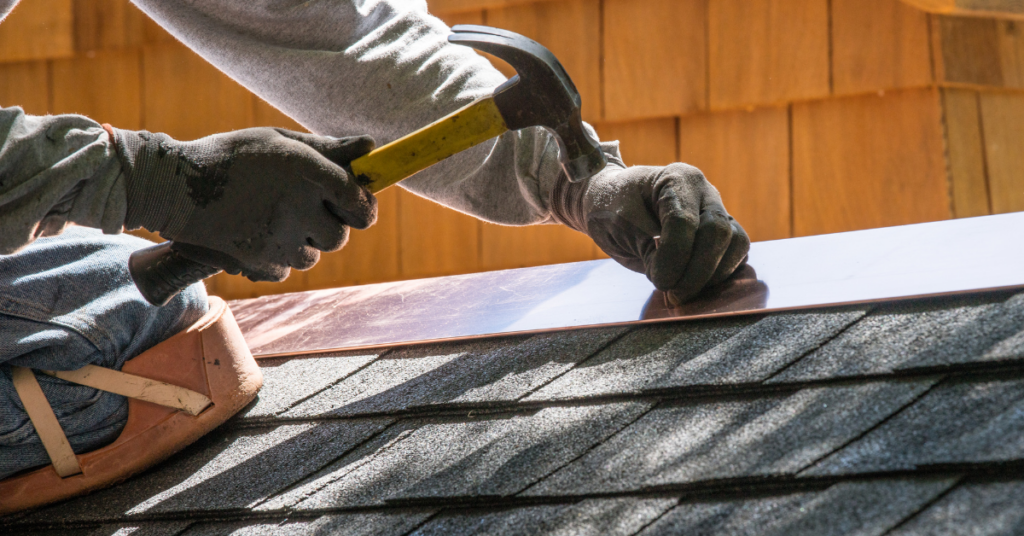
Roof flashing is a crucial yet often overlooked component of your home’s defense against the elements. At Stutzman & Kropf, we highlight the significance of proper roof flashing to shield your home from water damage, particularly given the frequent rain in the Willamette Valley. Let’s explore what roof flashing is, the various types, and why it’s vital for protecting your home.
What is Roof Flashing?
Roof flashing is a thin material, commonly made from aluminum, copper, or galvanized steel, that professional roofers use to direct water away from key areas of the roof. These include intersections, edges, and features like chimneys, skylights, or vents. Proper flashing installation ensures that water flows safely off the roof and into the gutters, preventing leaks and damage.
Types of Roof Flashing
Different areas of the roof require specific types of flashing:
- Step Flashing: Used where the roof meets a wall.
- Valley Flashing: Placed in the valleys where two roof planes intersect.
- Vent Pipe Flashing: Installed around any pipes that protrude through the roof.
- Drip Edge Flashing: Found along the roof’s edges to guide water into the gutters.
- Chimney Flashing: Seals the area around the chimney to prevent water from seeping in.
How Roof Flashing Protects Your Home
Roof flashing is critical for several reasons:
- Directs Water Away from Critical Areas: By channeling water away, flashing prevents leaks in vulnerable spots.
- Prevents Structural Damage: Without proper flashing, water can seep into the roof structure, causing rot and damage.
- Extends Roof Lifespan: Keeping water out helps maintain the integrity of the roof, prolonging its life.
Signs of Flashing Problems
It’s important to regularly inspect your roof for potential flashing issues. Here are some signs to look out for:
- Visible Rust or Corrosion: Indicates that the flashing material is deteriorating.
- Loose or Missing Flashing: Compromises the roof’s ability to repel water.
- Water Stains or Leaks Inside the Home: A clear sign that water is getting through.
- Damaged Shingles Around Flashing: Can indicate underlying flashing problems.
The Importance of Professional Installation
Proper installation of roof flashing is vital to its effectiveness. Here’s why you should trust professionals like us at Stutzman & Kropf:
- Ensuring Proper Installation: Our team has the expertise to install flashing correctly, ensuring maximum protection.
- Common DIY Mistakes: Inadequate sealing and improper placement are common DIY errors that can lead to serious issues.
- Benefits of Experience: With our experience, we know the best practices and materials to use for long-lasting results.
Our Expertise: Master Shingle Applicator Certification
At Stutzman & Kropf, we have earned the Master Shingle Applicator Certification through CertainTeed. This certification demonstrates our dedication to excellence and our deep understanding of shingle installation techniques. The program covers good workmanship practices, roof systems, estimating, flashing, ventilation, and detailed product installation instructions for all CertainTeed shingle products. This means when you choose us, you can trust that every aspect of your roof, including flashing, is installed to the highest standards.
Maintenance Tips for Roof Flashing
To keep your roof flashing in top condition, regular maintenance is key:
- Regular Inspections: Schedule periodic roof inspections to catch issues early.
- Cleaning Debris: Remove leaves, twigs, and other debris that can trap moisture.
- Prompt Repairs: Address any issues as soon as they are discovered to prevent further damage.
Protect Your Home with Stutzman & Kropf
Roof flashing is crucial for safeguarding your home against water damage. By ensuring it is properly installed and maintained, you can prevent leaks and prolong the life of your roof. If you need a roof inspection or maintenance, contact Stutzman & Kropf. Our skilled team is dedicated to ensuring your home remains safe and dry.
